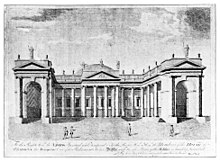Member of Parliament (pre-Union Ireland)
| Parliament of the Kingdom of Ireland | |
|---|---|

|
|
| Type | |
| Type | |
| Houses |
House of Lords House of Commons |
| History | |
| Established | 13th century |
| Disbanded | 31 December 1800 |
| Succeeded by | Parliament of the United Kingdom |
| Leadership | |
|
The Earl of Clare
Since 1789 |
|
|
John Foster
Since 1785 |
|
| Elections | |
| Ennoblement by the monarch or inheritance of a peerage | |
| First past the post with limited suffrage | |
| Meeting place | |
 |
|
| Parliament House, Dublin | |
| Footnotes | |
|
See also: Parliament of Great Britain |
|
The Parliament of Ireland was the legislature of the Lordship of Ireland, and later the Kingdom of Ireland, from the 13th century until 1800. It was modelled on the Parliament of England and from 1537 comprised two chambers: the House of Commons and the House of Lords. The Lords were members of the Irish peerage ("lords temporal") and bishops ("lords spiritual"; after the Reformation, Church of Ireland bishops). The Commons was directly elected, albeit on a very restricted franchise. Parliaments met at various places in Leinster and Munster, but latterly always in Dublin: in Christchurch Cathedral (15th century),Dublin Castle (to 1649), Chichester House (1661–1727), the Blue Coat School (1729–31), and finally a purpose-built Parliament House on College Green.
The main purpose of parliament was to approve taxes that were then levied by and for the Dublin Castle administration. Those who would pay the bulk of taxation, the clergy, merchants and landowners, naturally comprised the members. Only the "English of Ireland" were represented until the first Gaelic lords summoned during the 16th-century Tudor reconquest. Under Poynings' Law of 1495, all Acts of Parliament had to be pre-approved by the Irish Privy Council and English Privy Council. Parliament supported the Irish Reformation and Catholics were excluded from membership and voting in penal times. The Constitution of 1782 amended Poynings' Law to allow the Irish Parliament to initiate legislation. In 1793 Catholics were re-enfranchised.
...
Wikipedia
